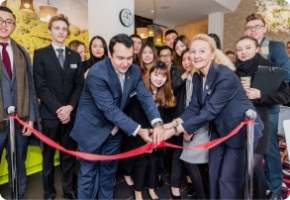- About
- Programs
- Campus Life
- Career Services
- Admissions
- News & Events
- Alumni
Mastering Cultural Competence in the Workplace: A Key Skill to 'Be World Ready'
Mastering Cultural Competence in the Workplace: A Key Skill to 'Be World Ready'
Understanding and leveraging cultural differences is crucial for enhancing team dynamics, operational efficiency, and competitiveness in the global hospitality industry. Erin Meyer’s book, "The Culture Map," offers valuable insights and a comprehensive framework for businesses to navigate cultural diversity, fostering more cohesive and effective teams.
In today's interconnected global economy, cultural competence is more than a desirable trait; it's a strategic imperative. Erin Meyer’s book, "The Culture Map," provides a detailed framework for understanding and leveraging cultural differences to enhance team dynamics, operational efficiency, and overall competitiveness. Meyer’s insights offer a roadmap for businesses to navigate the complexities of cultural diversity and build more cohesive, innovative, and effective teams.
Understanding the Dimensions of Culture
Meyer’s framework revolves around several key dimensions of culture: Communication, Evaluating, Persuading, Leading, Deciding, Trusting, Disagreeing, and Scheduling. Each dimension provides a lens through which organizations can understand cultural differences and adapt their practices accordingly.
Communication: Cultures vary significantly in their communication styles. Meyer categorizes communication as either low-context (explicit) or high-context (implicit). For instance, American business culture tends to be low-context, valuing direct and clear communication, while Japanese culture is high-context, where meaning is often derived from context and non-verbal cues. Recognizing these differences can prevent misunderstandings and foster clearer, more effective communication within multicultural teams.
Evaluating and Persuading: Different cultures have distinct approaches to feedback and persuasion. In some cultures, like the Dutch, feedback is given directly, while in others, like in Thailand, it is delivered more subtly to maintain harmony. Understanding these differences can help managers tailor their feedback methods to be more effective and culturally sensitive.
Improving Team Harmony and Cooperation
Cultural competence within teams is essential for fostering effective collaboration and reducing misunderstandings. Meyer’s dimensions of Trusting and Disagreeing are particularly relevant here. Trust can be either task-based or relationship-based. In the U.S., trust is often built through achievements and tasks, whereas in many Asian cultures, it is built through personal relationships. Recognizing this can help teams develop stronger bonds and work more cohesively.
An excellent example of a company that has integrated Meyer’s concepts into its corporate culture is Patagonia. The company’s commitment to environmental sustainability and social responsibility is complemented by its dedication to cultural competence. Through extensive cultural training programs, Patagonia fosters an inclusive environment, enabling teams to collaborate effectively across cultural boundaries.
Strategic Adaptation to Global Markets
Understanding cultural nuances can drastically improve how services are marketed and delivered. Erin Meyer’s concept of the 'Cultural Map' helps businesses navigate these nuances, adapting marketing strategies to align with local preferences and communication styles. For instance, promotional materials that resonate well in one cultural context might need adjustment in another due to differing values and communication styles.
In corporate settings, cultural competence is crucial when managing cross-border teams or engaging in international negotiations. Meyer’s research illustrates how American directness in communication contrasts with the Japanese preference for subtlety and indirectness. Recognizing and adapting to such differences is vital for successful corporate strategies, fostering better collaboration and avoiding potential conflicts.
Moreover, cultural perceptions of time vary. Linear-time cultures (like Germany and the UK) emphasize punctuality and scheduling, while flexible-time cultures (such as those in the Middle East and Latin America) view time as a more fluid concept. Companies that tailor their operations and customer service to these cultural perceptions can achieve higher customer satisfaction and retention rates.
Adopting cultural intelligence in business operations allows companies to effectively adapt their strategies to local norms and consumer behaviors. For instance, understanding how different cultures handle negotiations can lead to more successful business deals. In the U.S., where negotiations are direct, businesses can adopt a straightforward approach. In contrast, in South America, where negotiations are more relationship-oriented, businesses might focus on building long-term relationships rather than pushing for immediate results.
Driving Customer-Centric Innovation
Cultural nuances significantly influence the development and delivery of innovations in the service industry. For example, IKEA has successfully adapted its product offerings to respect local cultural values and preferences. Known for its commitment to sustainability and ethical business practices, IKEA offers products that cater to the specific needs and tastes of different regions. This approach respects cultural preferences and broadens IKEA’s customer base while reinforcing its commitment to sustainability.
Similarly, understanding cultural preferences in technology can guide the design of user interfaces. A digital banking app might offer different designs in different regions: a more vibrant and detailed interface in East Asia, where high-context communication is prevalent, versus a minimalistic design in Scandinavia, where low-context communication dominates.
In hospitality, understanding cultural nuances is crucial. Accor Hotels, for example, has implemented Planet 21, an ambitious environmental and social responsibility program. Part of this initiative involves adapting their food and beverage offerings to reflect local tastes and sourcing practices, catering to cultural preferences and minimizing environmental impact by using local, sustainable ingredients.
Hilton Hotels provides another example. They adapted their app to include features that cater to cultural preferences in communication and service management. In Asia, the app includes options for communication in multiple local languages and integrates features preferred in high-context cultures, like detailed information about local customs and etiquette.
Enhancing Organizational Behavior and Leadership
Leadership within multinational corporations benefits immensely from high levels of cultural competence. Leaders who exhibit cultural empathy and adaptability are more successful in motivating diverse teams, resolving conflicts, and driving innovation. Meyer’s insights into leadership styles highlight that what is considered assertive and strong in one culture might be viewed as aggressive and overbearing in another. Training leaders to adapt their management styles based on cultural context can lead to more effective governance and higher morale.
Organizational behavior also improves when cultural diversity is managed well. Diverse teams that operate with a high level of cultural understanding tend to have lower turnover rates, higher job satisfaction, and greater creative output. This is due to a more inclusive work environment where employees feel valued and understood.
Erin Meyer’s "The Culture Map" provides a comprehensive framework for understanding and leveraging cultural differences within organizations. By applying Meyer’s dimensions of culture, businesses can enhance team dynamics, leadership effectiveness, and overall operational efficiency. Continuous cultural learning and the integration of cultural competence into everyday business practices are essential for maintaining a competitive advantage in today’s globalized world. Companies like Patagonia, IKEA, Hilton Hotels, and Accor Hotels exemplify the benefits of cultural competence, showcasing how ethical and innovative practices can drive internal team success and global business excellence.
Ready to thrive in a global workplace? Discover how our programs can help you master cultural competence
#Industry News












